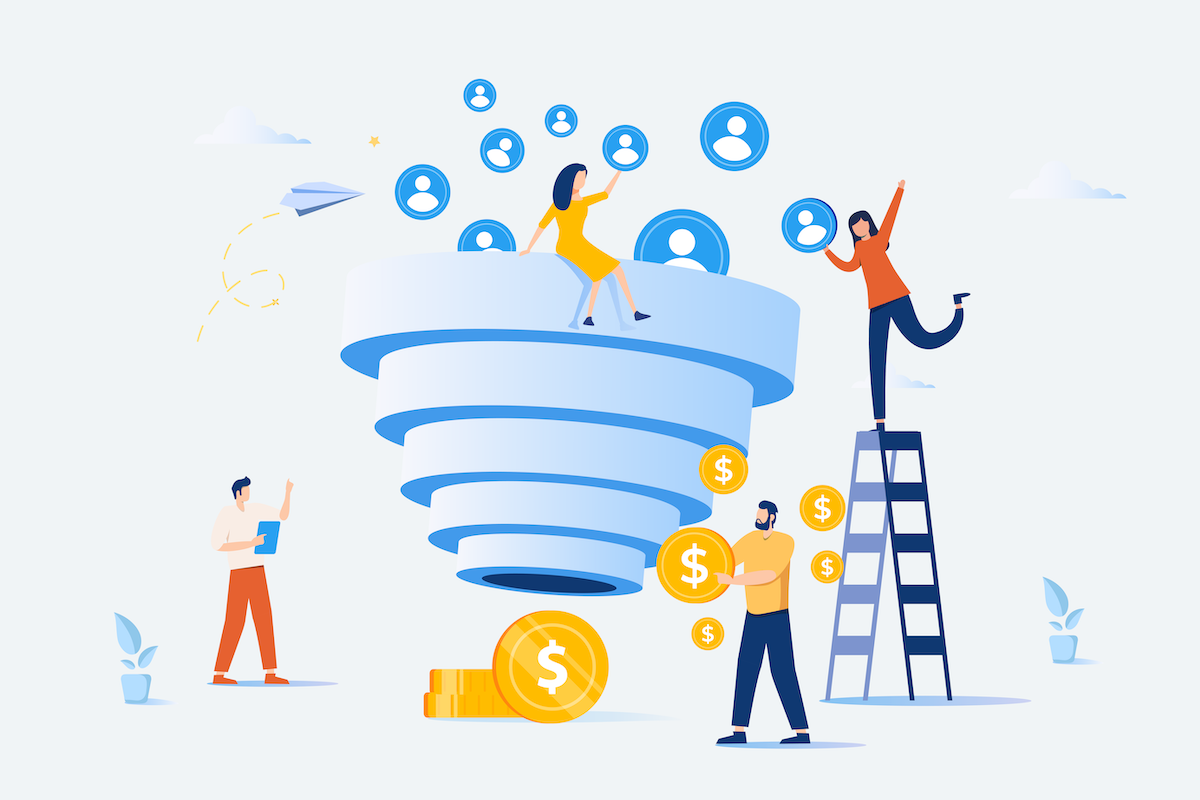Effective sales funnel management is important for optimizing your sales team’s performance. A well-managed sales funnel will move prospects through the sales process faster, reduce stalled opportunities, and help your team win more business.
What Is a Sales Funnel?
The sales funnel describes how customers move through the sales process. The funnel starts when a buyer first becomes aware of your company and ends when they become a paying customer.
The top (or beginning) of the funnel has a wide mouth, to capture as many qualified opportunities as possible. As some of these opportunities convert from leads to prospects, they move through your sales process (and down the funnel).
At each stage, some prospects are disqualified or don’t proceed, and the funnel narrows to include only those who continue along the buyer’s decision process.
Every funnel varies based on slightly different mixes of product, service, position in the market, and other factors.
Common stages of the sales funnel include:
- Awareness
- Qualification
- Consideration
- Purchase
Your role as a sales leader is to help your team fill the funnel with as many qualified prospects as possible and progress the most profitable deals.
What’s the Difference Between Sales Funnel and Sales Process?
The sales funnel describes how potential customers move through your sales process. The sales process describes the steps your team takes to progress prospects from one funnel stage to the next.
It’s important to note another process that runs alongside the sales process and sales funnel: the buyer’s journey. The buyer’s journey is the path buyers take as they become aware of, consider, evaluate, and decide to purchase a new product or service.
This includes marketing touchpoints and brand interactions that occur before a buyer enters the funnel as a lead.
What’s the Difference Between Sales Funnel Management and Sales Pipeline Management?
Sales funnel management is closely connected to sales pipeline management. Pipeline management is the process of ensuring there are enough potential customers in each stage of the sales cycle to meet sales goals.
Sales funnel management refers to managing each prospective customer’s journey through the sales process.
The most effective sales teams align the sales process with the buyer’s journey and engage in best practices for both pipeline management and sales funnel management.
4 Best Practices for Managing a Sales Funnel
1. Connect the Marketing Funnel to the Sales Funnel
Marketing and sales alignment is critical to maximize revenue generation. Because the sales funnel depends on a healthy marketing funnel, you need to make sure they’re connected and working toward the same goals.
Sales needs to define what a good lead is. Marketing needs to generate leads that will eventually turn into closed business. It’s not enough to fill the funnel; it has to be filled with the right opportunities.
Specify the metrics that matter. Agree on the definition of a marketing qualified lead, sales qualified lead, and other business-specific metrics.
Establish accountability. Use service-level agreements between marketing and sales teams to define goals for the quantity and quality of leads passed from marketing to sales. Likewise, define goals for response times and closing ratios for the sales team to strive for.
Meet regularly. Ongoing communications and scheduled meetings allow your teams to address any changes in the marketing funnel and/or sales funnel, and to share new information related to customer behavior.
This process takes time and investment, but it’s worth the effort. When sales and marketing teams are in sync, companies close more deals.
2. Track Prospects Through the Funnel
Clearly define criteria for prospects to move from one funnel stage to the next. Create a sales funnel chart and communicate with your sales team about criteria and expectations.
Make sure sales managers set and convey clear expectations of sales professionals about maintaining accurate and up-to-date data on each customer’s stage in the sales funnel.
This information can be used to target messaging and optimize the sales process. It also helps ensure more accurate sales forecasting.
3. Target Messaging Based on Funnel Location
Knowing where prospects are in the funnel helps your sales professionals target messaging that is appropriate for each stage.
Train sales professionals to change the way they communicate with sales leads based on where they are in the funnel, and to maintain a steady cadence of communication appropriate to each funnel stage.
For example, someone near the top of the funnel will be interested in educational thought leadership, industry news, and webinars.
In the middle of the funnel, as they evaluate and compare your solution to others, prospects will appreciate product sheets, white papers, and case studies.
At the bottom of the funnel, as prospects move closer to purchase, it’s best to send customer testimonials and information that conveys the value of your solution.
Work with your marketing and sales enablement functions to ensure every member of your team has access to content appropriate for every stage of the sales funnel.
4. Measure and Adjust
Measure key metrics at every stage of the funnel. Conversion rates from one stage to the next indicate how well prospects are moving through the funnel.
Changes in conversion rates can reveal issues or show an increase in stalled leads. Define when a lead is “stale” and should be moved out of the funnel and into a marketing nurture sequence.
Rather than allowing stagnant leads to clog your sales pipeline, coach your sales professionals to use a standard outreach. For example, a seller who has been unable to contact a lead after 30 days could send the contact a final “breakup” email, letting them know they’re moving on.
Keeping the funnel free of stalled leads can help your team focus on higher quality prospects and allow more accurate sales forecasts.
A Road Map for Managing the Sales Funnel
Sales leaders, give your team a road map for managing the sales funnel and closing more business in less time. Learn proven techniques to optimize your sales process, keep deals moving through the sales funnel, and improve sales results through The Brooks Group Sales Pipeline Management training program.




